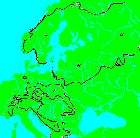 Range of Picea abies: I = Alpine - southeastern European region II = Herzyne - Carpathiam region III = Nordic - Baltic region (5). | Picea abies (Linnaeus) Karsten 1881Common NamesNorway spruce, epicéa commun (French French) (4), épinette de Norvège (Canadian French) (2), gemeine fichte (German), jel europeiskaya (Russian) (4).Taxonomic notesSyn: Pinus abies Linnaeus 1753 (2); P. rubra A. Dietr.; P. vulgaris Link; P. excelsa Link; P. montana Schur; P. abies var. europaea (Tepl.) Jurkev. et Parv.Numerous varietal and subspecific names have been published, but few are sufficiently distinct to be worth recognising. The most widely recognised is var. acuminata (Beck) Dallimore & Jackson from the SE of the range in the Balkan Peninsula (4). A large area of hybrid introgression with P. obovata has developed since the two species met after the last Ice Age between the Ural Mts and Finland, treated as Picea × fennica (Regel) Komarov (4). Some authors treat P. obovata as a subspecies or variety of P. abies. Its closest relationship is probably with the P. asperata complex of China, which are often similar in cone morphology and foliage (7). The species Picea alpestris Brügger ex Stein is commonly treated as a variety, P. abies var. alpestris (Bruegger) P. Schmidt (4), but is distinct in morphology and probably more closely related to P. obovata and other allied Asiatic species (7). DescriptionTrees to 40-50 m tall and 100-150 cm dbh; crown conic. Bark orange-brown, finely flaking, becoming gray-brown, scaly on old trees . Branches short and stout, the upper level or ascending, the lower drooping; twigs orange-brown, usually glabrous. Buds reddish brown, 5-7 mm, apex acute. Leaves 1-2.5 cm, 4-angled in cross section, rigid, light to dark green, bearing stomata on all surfaces, apex blunt-tipped. Seed cones (10-) 12-16 cm; scales diamond-shaped, widest near middle, 18-30 × 15-20 mm, stiff, leathery, margin at apex erose to toothed, apex extending 6-10 mm beyond seed-wing impression. 2 n =24 (2, 9).Var. acuminata is distinguished by longer-than-average cones (to 18 cm, the longest of any spruce) with more acute cone scales (4). Hybrids with P. obovata ( P. × fennica) and P. alpestris show pubescent shoots and cones with more rounded scales (9). RangeN, C & E Europe outside permafrost areas south to N Greece and W to the Massif Central, France; south of 47° N latitude only in mountains above 400-500 m; ascends to 2200 m in the Balkans (5). In the NE, there is a broad zone of hybridisation with P. obovata (1, 3). USDA hardiness zone 4 (Balkan origins, var. acuminata, zone 6).Locally naturalized in Europe out of its native range including Britain and the Pyrenees Mts., and in the north-central United States (and adjacent Canada) (2). Big TreeHeight 52 m, dbh 320 cm, located at Central Forest Reserve, Valdai Highlands, W of Moscow, Russia (3) This is an extraordinary figure; normally 100 cm dbh is a very large specimen, and it is possible that this tree in fact has a girth of 320 cm. A tree 45 m tall with 153 cm dbh is recorded from the Bagni di Mezzo, Trentino Alto, San Pancrazi, BZ, Italy (6). Reports of trees to 55-60 m tall in the Vosges and Jura Mts of France await verification. Tallest cultivated tree in UK is 52 m at Moniac Glen, Inverness, and stoutest in UK is 147 cm dbh at Lingholm, Cumbria (8).OldestRarely exceeds 220 years in cultivation in Britain and Denmark. As with most species in the Pinaceae, the oldest trees are likely to be found at high altitudes on difficult sites with slow growth (9).DendrochronologyEthnobotanyA timber tree of major economic importance throughout the cool temperate areas of Europe. The commonest tree used for Christmas trees in Britain, despite its poor suitability for this purpose, with the leaves soon shed as it dries out. A herbal tea can be made from the leafy twigs and is reputed to have various curative powers, not tested medicinally.ObservationsRemarksThe most widely used horticultural spruce in North America; many cultivars exist, including dwarf shrubs (2).The most climatically tolerant species in the genus, happy in cultivation in both extreme oceanic NW Scotland and central continental Wisconsin, possibly due to adaptations to rapidly fluctuating climates in Europe during the Ice Ages. Citations(1) Silba 1986 .(2) Ronald J. Taylor at the Flora of North America web site . (3) Vladimir Dinets, e-mail communication, 2-Jan-1998. (4) Farjon 1990 . (5) Vidakovic 1991 . (6) CORPO FORESTALE DELLA STATO , a listing of big trees in Italy. (7) Frankis, M. P. 1992. Picea. In: A. Huxley, M. Griffiths & M. Levy (eds.) The New RHS Dictionary of Gardening 3: 570-573. (8) Mitchell et al. 1990. (9) M.P. Frankis, personal observations, reported 6-Jan-1999. See also This page co-edited with M.P. Frankis, Jan-1999. |
[Picea] [Pinaceae] [home] This page is from the Gymnosperm Database |